Index relies entirely on the support of donors and readers to do its work.
Help us keep amplifying censored voices today.
[vc_row][vc_column][vc_column_text]
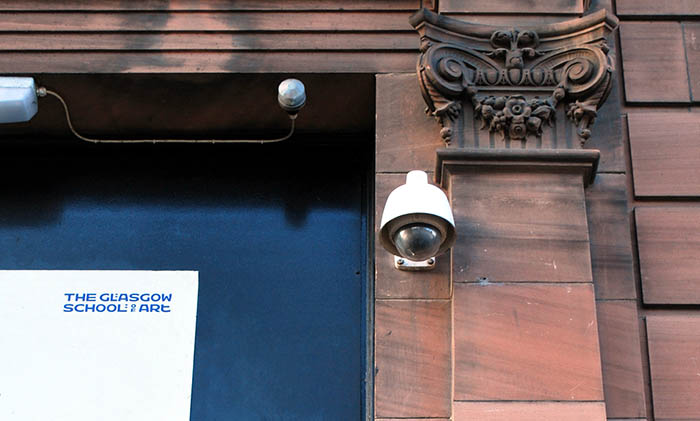
Glasgow School of Art. Credit: James Oberhelm
After the Glasgow School of Art censored an artwork by master of fine art student James Oberhelm from a May 2017 interim show when it was deemed to contain “inappropriate content”, the commitment of the world-famous institution to free speech has again come into question. Students enrolled in the programme were issued an updated handbook in November 2017 with provisions that would make such censorship much more likely and much easier to enforce in future.
These were without precedent, urging students to exercise caution when it comes to “offensive” or “inappropriate” material and warning against “bringing the institution into disrepute”. It goes on to say that the “right to freedom of speech is not absolute”, requiring students to adhere to the “highest ethical standards” and “ethical good practice”.
Over two-thirds of MFA students at the school have signed a petition calling for such rules to be removed and demanding an environment where they can work “free from the threat of being banned by GSA”. “Censorship is fundamentally a point of principle, even if it doesn’t affect an individual practice right now,” it adds.
Oberhelm is one of the 34 out of a total of 50 MFA students who have signed the recent petition. His artwork, “Effects” [The Enthronement], explored the geopolitics of the Middle East and included a propaganda video created by Isis. An email between staff members at the art school stated that Oberhelm’s “needs to be looked at by the Prevent Group”, referring to the UK’s counterterrorism legislation Prevent. Past and present staff at the institution have confirmed to Oberhelm that this was the first case of censorship in its history.
“It’s self-evident that open expression is fundamental to creative work and study,” he told Index. “The threat of censorship undermines open expression and the attempt to engender self-censorship is corrupting to art practice and to art education. Art is a space of potential and a discipline of vital exchange, not a tool for social engineering and ideological conformity.”
Henry Rogers, MFA programme leader at the school, replied to the signatories of the petition with the following [sic]: “we have as a team discussed petition about the ethical practice advisory statements in the MFA Handbook that some people have signed. Of course we are happy to look at this when preparing the 2018-2019 Handbook (normally a summer task for staff) and will consult you again at that point once the handbook has been revised. If there are any other amendment you feel you want to bring to the fore, please do let me know.”
“The MFA programme leader’s response is unsatisfactory in that it has simply delayed the decision until after this academic year ends, thus ensuring that an entire year of students, who have become well-informed about GSA’s advancing censorship practices, will be gone when a decision is made,” Oberhelm said. “While this delay of many months might come dressed in a procedural rationale, it also looks very much like the time-honoured institutional strategy of drawing out the process till the opposition dissipates.”
But Oberhelm remains hopeful that the Glasgow School of Art “still has the wherewithal to defend its reputation by removing these written directives, and ceasing the practice of briefing incoming postgrad students to police their art practice, rather than allow its reputation to become steadily more tarnished”.
Below is a list of works that likely wouldn’t be acceptable forms of expression under the Glasgow School of Art’s new rules and provisions:[/vc_column_text][/vc_column][/vc_row][vc_row][vc_column][vc_media_grid grid_id=”vc_gid:1526900889337-d0a3a21c-65dc-2″ include=”99601,99606,99603,99605,99602,99604″][/vc_column][/vc_row]
[vc_row][vc_column][vc_single_image image=”97113″ img_size=”full” add_caption=”yes”][vc_column_text]In September 2016, I received an email from Javaad Alipoor, artistic director of Northern Lines Bradford, who wrote to Index on Censorship to discuss plans for his new play, The Believers Are But Brothers, which explores the radicalisation of young Muslim men and the legal limits of freedom of expression.
Index was particularly keen to work with Alipoor on this issue because two art works dealing with radicalisation, had recently fallen foul of censorship: In September 2015, the artist Mimsy’s satirical installation ISIS threaten Sylvannia had been removed from the Passion for Freedom exhibition at the Mall Gallery on the advice of a police officer who believed that the work was potentially inflammatory. In August the same year, the newly commissioned work Homegrown by Nadia Latif and Omar El-Khairy, which also addressed radicalisation, had been cancelled by the National Youth Theatre for reasons which remain obscure.
In May 2017, a few months before the play premiered at the 2017 Edinburgh Festival, “Effects” (The Enthronement) by MA student James Oberhelm which was to include a video monitor playing two propaganda videos issued by Isis in 2014, was removed from the degree show at Glasgow School of Art.
It seemed possible that Alipoor’s important new play might suffer a similar fate.
However, The Believers Are But Brothers bucked this trend. A work in progress performance was held at the Oval House in London and West Yorkshire Playhouse and it went on to win a Scotsman Fringe First Award, meeting with considerable critical acclaim.
What steps did Alipoor and Luke Emery, producer of the piece, take to ensure the play had the best chance of steering clear of an emerging trend for police and others in authority, to foreclose on artwork that engages with one of the most contentious issues of contemporary UK politics? Here, in their own words, they talk about their process.[/vc_column_text][/vc_column][/vc_row][vc_row][vc_column][vc_custom_heading text=”Javaad Alipoor:” font_container=”tag:h3|text_align:left” use_theme_fonts=”yes”][vc_column_text]
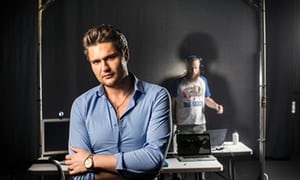
Javaad Alipoor is a writer, theatre maker and director. As well as running a theatre company, he is Resident Associate Director at The Crucible (Sheffield Theatres Trust) and an Associate Director of Theatre in the Mill. He makes work at different scales, building cross-platform digital and hard end community work into everything he does.
His recent work for theatre includes The Believers Are But Brothers (actor/writer/co-director), The Rising of the Moon (writer/director), Bassett (director).
I originally wanted to make a show about ISIS brides. I found out these young women who had gone to the Islamic state and married jihadis had twitter accounts, so I started following and engaging with them. What struck me was the register of their propaganda. One tweeted out this picture of a guy I called Game of Thrones Jihadi. He’s ripped. He’s got this vest on, pecks, scar-bitten, a big gun. The slogan around him was words to the effect – ‘Sisters what kind of a man do you want? Some boring guy who works in an office, or this brother who will die for you’. There was always this offer – fuck this grey, boring England and come and live in a Hollywood film. What the white narrative wanted to do was take agency away from these women who had done these awful thing because they had been tricked into it. But actually an offer is being made. You get some power when you go. At the height of the Islamic State almost all the women’s Sharia policing department in the capital in Raba was made up of European Muslims. You get to push other women around.
When I started looking into it I realised that it’s not my show to make and I ended looking at the similar narrative for men which goes: there is a certain type of young Muslim man for whom the complex identity of being a Muslim in the west is too much. So he withdraws to this black and white world. But all the serious work on this suggests the opposite; journalists like Martin Chulov does this really well. And if you do your own research and engage with these people, the way they use social media to try and get the message out, is very similar. It’s not ‘come to something simple’, but ‘come to something more exciting’. So again, facetiously – there were two lads from Plymouth who were killed in a drone strike in ISIS controlled Syria and the headline in The Star was something like ‘What could make these two lads who worked in a phone shop in Plymouth go off to join the Islamic State?’ The clue’s in the question!
So this became a show about young men – fantasy, religion, technology; and about the way masculinity has changed since the 1970s. I think there is a bunch of us who are alright with the fact that women and sexual minorities have more rights, and a bunch who fucking aren’t on board with that at all. And some of the ways that that works out is culturally inflected, whether you want to talk about the alt right, or ISIS, or Hindutva in India. Obviously the Muslim identity is part of that; but it isn’t saying there is a problem with Muslim young men, there is a problem with young men. Let’s get at that.
In the show [the audience] get sent some screen grabs of an issue of Dabiq, the ISIS’ in-house theoretical journal, which explains the grey zone theory how it is going to collapse and you are going to have to decide. Most of the ISIS propaganda in the show is projected. Whereas you get more Four Chan stuff on WhatsApp to work dramaturgically. We were uncertain about sending the audience a link to Four Chan. As soon as you go on Four Chan there’s kiddy porn and rape videos. There are two inter-related questions – one is – can I send that to someone and the other is should I? Part of the instinct is as a theatre maker – if you are going to walk up to the bell you should ring the bell. But it does then open up that ethical thing. Some of the edits we show are taken from ISIS videos where they glorify murdering people. We never show people being killed in the show, but you are never sure how far we will go and I think that tension works and we were able to be quite playful. The character I’m playing says – well I would have sent you that but I am not sure I can.
The research process is interesting to the extent that it’s that grey area of legality again. I read a blog called Jihadology – you’d worry about the guy who runs it, alongside a bunch of free and pay-for services. Are you a spook? I read a lot of Dabiq magazine – really beautiful, crisp design, intellectually utterly vapid. You can’t imagine anyone serious being persuaded by them. But you can imagine people being inspired by them. Extremist materials that glorifies terrorism, as these things clearly do, come under the Prevention of Terrorism Act. So the question is how does the white person with power look at you. How much is racialised and ‘classed’? Is it ‘stroppy Muslim with these horrible things on their phone’ things’ – guilty until proved innocent or is it actually ‘he’s an artist and intellectual thinking about these? It’s not unrelated to other types of criminalisation. If they pick you up with half an ounce of weed –– if you are mixed race and you come from a shit Northern town, you are a career criminal; if you’re from Oxford that’s a completely different kettle of fish. Because of this show, because the Guardian liked it, it’s bought me a bit more cultural capital.
What was interesting is that no-one was talking about Muslim sensitivity with this show.
The support that Index was giving me and the conversation with Luke was much more about white and police sensitivity. I knew about Homegrown and that soft censorship of a certain sort of white liberal; if there is any talk about police or terrorism, then that liberal space just collapses in on you. This is potentially a more serious thing.
My strategy preparing for the risks I was taking was to two-fold. One was to work with Index, because that felt like it was a conversation that was making people confident. The discussion with the barristers [brokered by Index] really marked a turning point in how we were talking about the problems. We’d got ourselves into this place of worse possible scenario – what’s the defence? Coming out of that meeting we saw it was more likely to be a bit of pressure from the police or the local authority, following a complaint from a panicked, overworked cultural institution, and then that caving in on itself. It was important to have a toolkit for disarming that panic in the first instance. If someone is worried, then let’s talk about it, we can discuss it. Practically, it is about disarming that subtle form of censorship, it’s a proactive way to increase the kinds of things that people of colour are allowed to talk about, and the kinds of conversations we’re allowed into. But more important, it was knowing where the networks of support are, where the allies are, where the people are who do know. If the shit really hits the fan, I am two phone calls away from someone who can help. [/vc_column_text][/vc_column][/vc_row][vc_row][vc_column width=”1/4″][vc_icon icon_fontawesome=”fa fa-quote-left” color=”black” background_style=”rounded” size=”xl” align=”right”][/vc_column][vc_column width=”3/4″][vc_column_text]
[/vc_column_text][/vc_column][/vc_row][vc_row][vc_column][vc_column_text]The other – comes out of who I am. I grew up in Bradford in the 1990s to early 2000s and the relationship with the police was horrendous, resulting in, among other things, three riots in five years. I am not one of nature’s fans of policing. I know a lot more about the first generation of Prevent because I was working for an organisation which made a decision to take that money, that not a little soul-searching was involved in, taking what was said at the time about autonomy from security services at face value. Post-coloniality has always been part of who I am. I’m quite a big believer of making sure that if there are people of colour in the room, they are the people who decide what the legitimate bounds of discussion lie. So there is a way of talking about the show, being really bold about what the show really is with the people who are co-commissioning, co-producing.
There is a political struggle, macho word struggle, who gets to say what and where. You can’t back away with this going on. There is a whole discourse and politics of risk how the industry theatre works that we need to shift. We take risks all the time, but the way we are willing to do it is mega-racialised. We lionise risks that are about white people and white canon and white artists; but where risks attached to black, colour, Muslim, are too difficult or too hard to take. I overheard some relatively sensible liberal people describing the appointment of Kwame Kwei-Armah [as artistic director of the Young Vic] as a bold move. I thought it’s a good move. Here is an internationally successful guy, running an internationally successful theatre.
More and more I am trying to say this to historically white institutions and the white people in positions of power who run them – just look at yourselves and your policy. Are you willing to overhaul how you racialise risk, to really open up in that way? If so, go back to your office and decide if you are going to start reading text and saying how many people in this play could be of colour, rather than saying this character is Chinese so go off to find a Chinese actor. There is a black and Asian middle class and they do not spend their money with these big historically white institutions, that’s your problem. In London you have a whole scene of BME theatre makers who are little more politically engaged and a little bit more industry savvy and there is a feeling of being a part of an international movement. We don’t have the concentration of those kind of people in the north necessarily.
I sit down with people running our regional producing houses in their big spaces where they feel the financial pressure and go ‘name three writers of colour who feel solid enough for your main house’. Much less than the fingers of one hand are the artistic directors who could name you 3 writers of colour who feel solid enough. August Wilson, Tarrell Alvin McCraney, Lorraine Hansbury these are big Afro-American names, but risk is attached to them in a way that, for instance an [Arthur] Miller, that no-one’s heard of, isn’t. The unknown Miller is a risk these buildings are ready to take.
Racialisation of risk cuts all the way through what we do in the cultural industries determining which risks are you willing to take. What does that mean? That some people get to do the talking and some people don’t. And that is for the me the link with censorship. It is a social model of censorship, more than that liberal historical thing – a social relation that empowers some people and massively disempowers others. It is censorship of omission rather than commission. What we are doing is censoring a whole bunch of voices that don’t fit in to the accepted narrative.
Some of the mainstream stuff gets its hands on it – like Four Lions – The State was a great example of it – but in a world where everything is a bit Homeland that’s the easy story of what trying to disrupt that narrative might mean. The right wing cliché that we really need to have this conversation about the problem Muslim community and radicalisation doesn’t take account of the fact that you have that conversation every fucking day in every fucking newspaper. It’s literally true that Muslims are a minority in this country and people of colour are a minority in a lot of advanced countries, but the flip of that is, because of the way racialisation works, we dominate news. So it is really important to work with artists who are stepping up to that.
[/vc_column_text][/vc_column][/vc_row][vc_row][vc_column][vc_custom_heading text=”Luke Emery:” font_container=”tag:h3|text_align:left” use_theme_fonts=”yes”][vc_column_text]
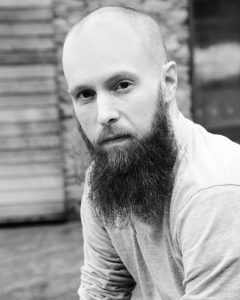
Luke Emery is an independent creative producer. His mission is to help people achieve the seemingly impossible across a spectrum of creative practices. Luke works with artists and organisations who challenge and excite their audiences and who aren’t afraid to ask difficult questions, whilst at the same time providing inviting and welcoming spaces for the public to engage with their work. He works outdoors, indoors and online and across the globe, wherever art can happen.
Our first conversations were purely practical about timing, funding, did we want to go to Edinburgh etc. But when I got to know Javaad and got into the meat of the text of what Javaad was looking at and what he revealed to me about his research activities, that certainly flagged concern. Initially I put up a barrier. It was as much as it was about protecting him as it was everybody who would be working on the project with us. Then, when he told me more about his relationship with the police and the Prevent team there were definitely tensions and previous history with the West Yorkshire Police. So these things were red flags to me. Not only were we in a difficult position because of what he had already done, but who he was as Muslim, left-wing activist and a vocal critic of Prevent and the UK police service.
With regards to his research approach, when we did, later on, talk about about it, I drew on my previous, activist background. I certainly have been spied on by Special Branch, and I would be very surprised if Javaad hasn’t, and in those environments you have to be super, super careful about how you communicate with other people in the movements. If we were talking about anything particularly sensitive we did it in person not by email, and in noisy outdoor places, where it is much harder to record people’s conversations. We used secure, encrypted video calling; we would leave our phones in other rooms so no-one could open up our lines through our phones. Perhaps we were a little bit overzealous, but initially the subject matter made me quite nervous, so I didn’t want to take any chances for him, or myself as the producer.
None of the things that Javaad and I did together were illegal. But whenever we were in the rehearsal room or we were talking about it, or Javaad was working off the reference material with some of the creatives, I would say: we are not asking you to research this, you don’t have to look at these things online, it is up to you, but we are not instructing you. There were a couple of points during the making of the show that I had to shut stuff down. One of them was Javaad wanted to show a video of a beheading. Initially he wanted to show it as an obvious clip and then as a subliminal piece of video. Subliminal footage, as far as I’m aware, is illegal, full stop. So I had to put a stop to that. So we had that conversation regularly about why I was doing that.
[/vc_column_text][/vc_column][/vc_row][vc_row][vc_column width=”1/4″][vc_icon icon_fontawesome=”fa fa-quote-left” color=”black” background_style=”rounded” size=”xl” align=”right”][/vc_column][vc_column width=”3/4″][vc_column_text]
[/vc_column_text][/vc_column][/vc_row][vc_row][vc_column][vc_column_text]Javaad and Kirsty (co-director) both wanted to send the audience a link to the website FourChan which features heavily in the piece. It is one of the most god awful places on the internet. Child pornography, revenge porn is posted, hate speech, racist cartoons. I vetoed that being included in the show because it would have taken us to the fringes of the Obscene Publications Act (OPA). And they said: but it’s on the internet. But there are lots of things that [are illegal] on the internet. If you put that on a WhatsApp group on someone’s phone in a way that is documented you could definitely be accused of breaching the OPA.
We always knew because of Javaad’s status as a Muslim, someone half Iranian, half English, he is already in a sensitive category for possible persecution, imprisonment or spurious legal charges. That was a big influence across the whole process. It was really interesting as a producer to make those considerations in a way that I don’t think I have ever have done for a white performer. We had to find the balance based on our own work and other work that has been shut down here and elsewhere in the world and make a judgement call. It was a bit of a leap into the unknown.
As a producer, a lot of what I do on a day to day basis is fairly stressful judgement calls. We talked a lot to the solicitors about Javaad’s previous history with the West Yorkshire Police, where there was the potential political and personal axe to grind and whether or to go to them up front about the show and pre-empt any intervention. This would mean us having to go and have a sit down with the police and say everything is fine, it’s just a theatre show. And because we just performing for two nights on a campus in a fairly under the radar fashion, it was much less of a risk just to do the play than reach out to the police and get their antenna up and then potentially to walk into a whole series of conversations that could have got very messy and complicated.
To a certain extent I felt that Index was balancing out some of the caution that we were getting from the [pro-bono] legal advice from solicitors. I think Javaad would say for sure that we were being over-cautious, but from my perspective the lessons I have learnt from people doing more activist focussed work, what some people might say is illegal activity, they can get caught out because they are not careful about how they talk about what they are doing. For me the worse possible scenario would be Javaad being put in prison, or even just getting arrested or hit with a legal bill, those were all factors that we would have no way of dealing with because our funding could never hope to stretch to legal fees. So that was the worse-case scenario. My job as producer working with artists is to be thinking not only about plan a, b, c, but worse-case scenario a, b, c and try and head them off before you get to them.
The inherent challenge for us around making work that is genuinely risk-taking in terms of the subject matter and its research activity is the funding implications of needing a legal team to work with us. Something in the long term that we will certainly be thinking about for work that is going to cause potential controversy, is if we need to partner with somewhere like a national theatre institution that has a legal team on a retainer with the ability to help us answer those questions, rather than it just being me and Javaad. Certainly when you are working independently or in a small company wanting to do risk-taking or controversial work, you should make allowances for legal consultation, but the costs are way beyond the scope of the average ACE grant.
It has been hugely positive experience. Less because of the political things we have learnt – but we have found that there is a huge appetite for this kind of work in the UK, the popularity of the show in Edinburgh speaks to that. And it translates nationally and internationally; it looks like we will tour internationally with this piece. I think the reason why this particular show is so successful is there is dearth of this kind of work being made on UK stages. People have been saying to us all the time about the show that it is all about things that they knew existed, but that they don’t want to have to look at. They know that there is real darkness on the internet and this show allows them to go into that world in ways that they wouldn’t otherwise have access to. Javaad is learning how to research something so he can take people into a world that they only see through a white perspective generally.
Asked how politically engaged work that is controversial and risks censorship could be better supported and so increase the number of producers interested in working in this area, Emery suggests the following:
– we need more face to face workshop opportunities or the opportunity to talk about the work itself. There are a lot of ‘how-to’ guides and video information, but face to face with experts and peers would be more useful.
– Having a lawyer available pro-bono to the process would be invaluable. Talking to the Barristers and the solicitor during the development of ‘The Brothers’ really enriched our understanding. We need advice on how we go through our own process and undertake our research with a good understanding of the legal framework we are operating in.
– A network of producers who want to take risk or who are doing politically charged work, to meet regularly for peer support.[/vc_column_text][three_column_post title=”Case studies” full_width_heading=”true” category_id=”15471″][/vc_column][/vc_row]
[vc_row][vc_column][vc_column_text]
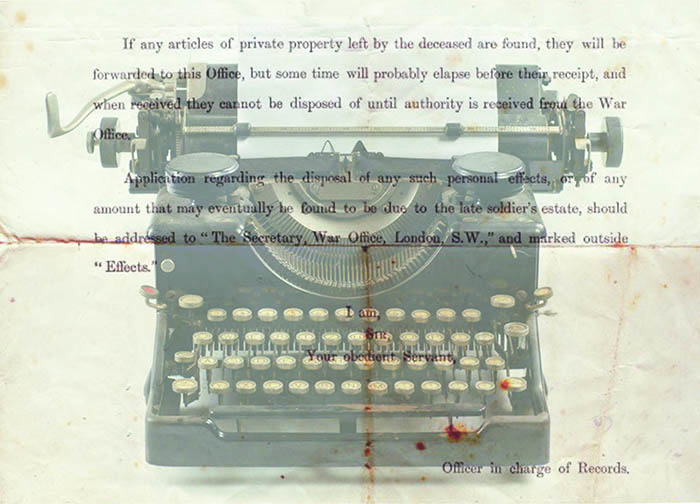
The flyer for masters student James Oberhelm’s banned artwork “Effects” [The Enthronement]
“Prevent is supposed to safeguard communities against the threat of terrorism, but the strategy is, in effect, counterproductive,” Melody Patry, Index on Censorship’s head of advocacy said. “The government should be encouraging discussions about how to counter radicalisation, but, in this case, it has clearly silenced the artist’s interrogation of extremism through his work.”
Oberhelm’s “Effects” [The Enthronement], which dealt with the geopolitics of the Middle East, was set to feature on the first day of the school’s Interim Show in May. It included two propaganda videos issued by Isis, one of which showed an execution carried out by the extremist group on the border between Syria and Iraq. As the emails state, this is “difficult imagery”.
Oberhelm acquired the films from the public domain and had planned for the work to feature several content warnings before showing the clips. An email from someone at GSA (the authors are redacted) on 10 April states: “I think this needs to be looked at by the Prevent Group.” The email goes on to say that the artwork “needs to be considered by the Head of School and with his line manager.”
Oberhelm says he was informed via email on 11 April that his work “is now going to be reviewed by the ‘Prevent Concerns Group.’” The group is “responsible for the strategic development and implementation of measures to meet the Prevent Duty”. His work was subsequently removed from the show.
Artist Bob and Roberta Smith spoke with Index about Oberhelm’s case: “Artists around the world are generally trying to do things that are permissible in democracies but sometimes not in their societies […] Artists must reserve the right to provoke society but that comes with risk and responsibility.”
What follows is a selection of emails made available by the Glasgow School of Art.
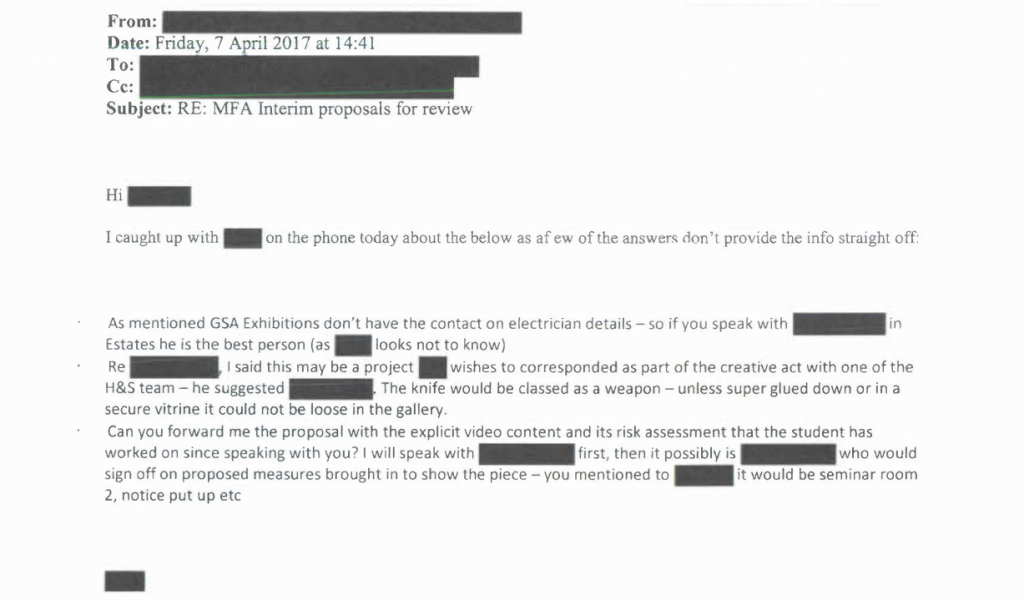
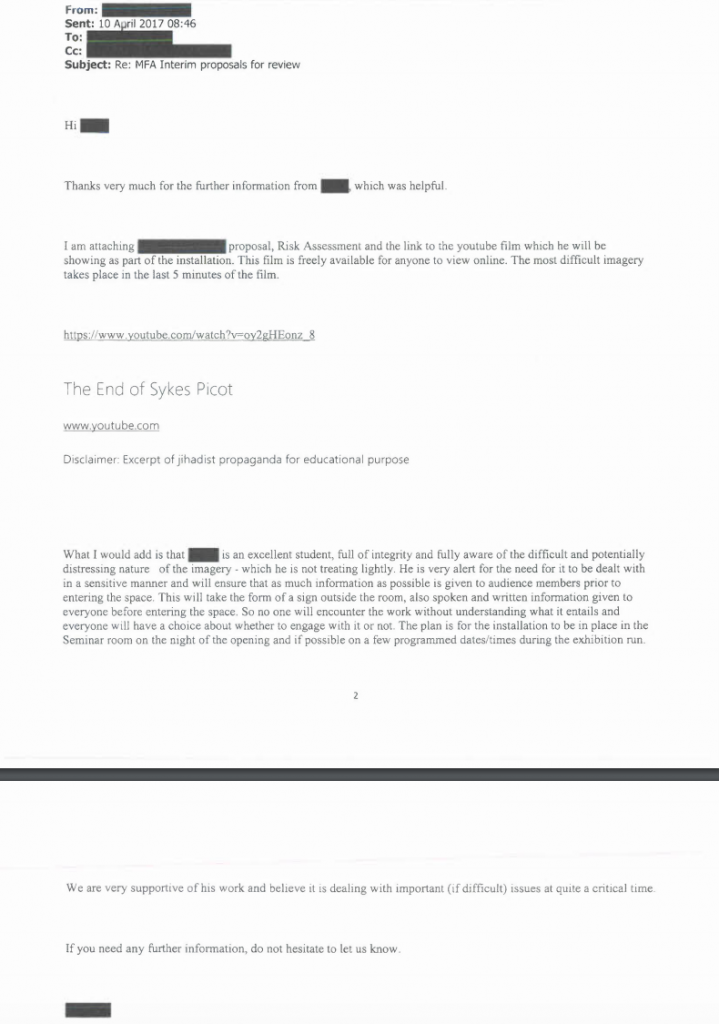
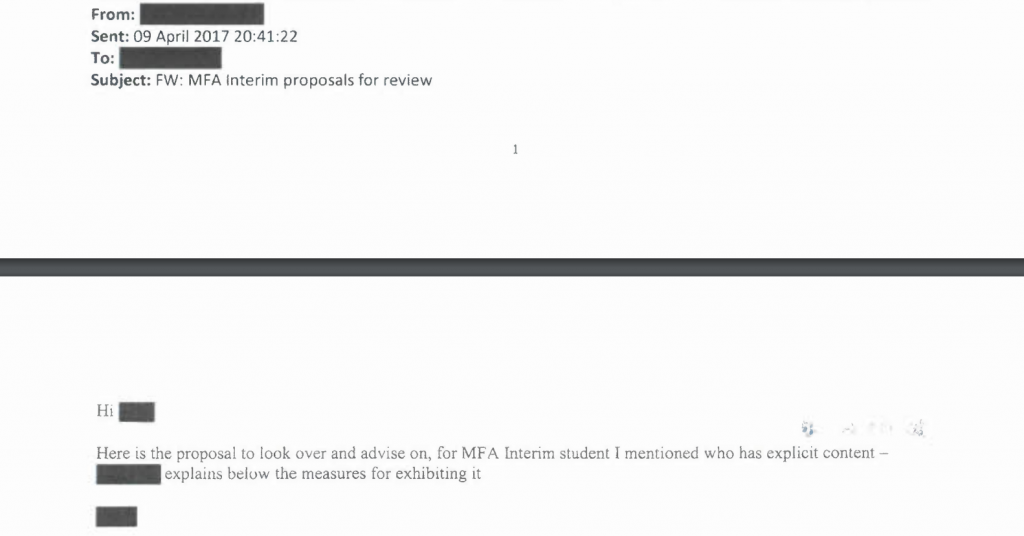
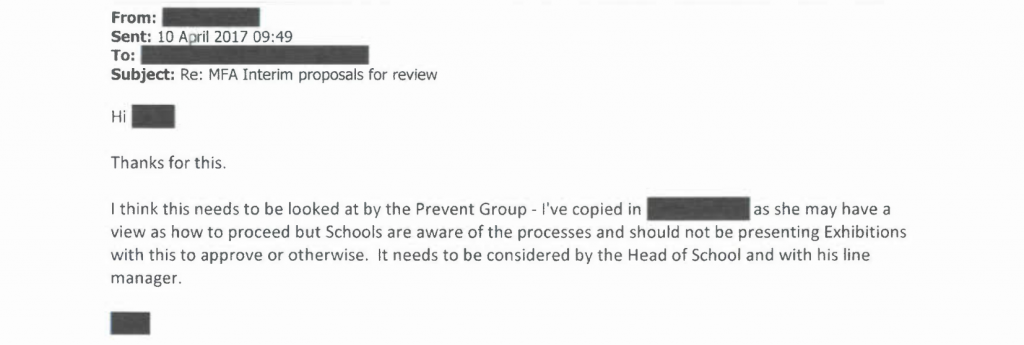

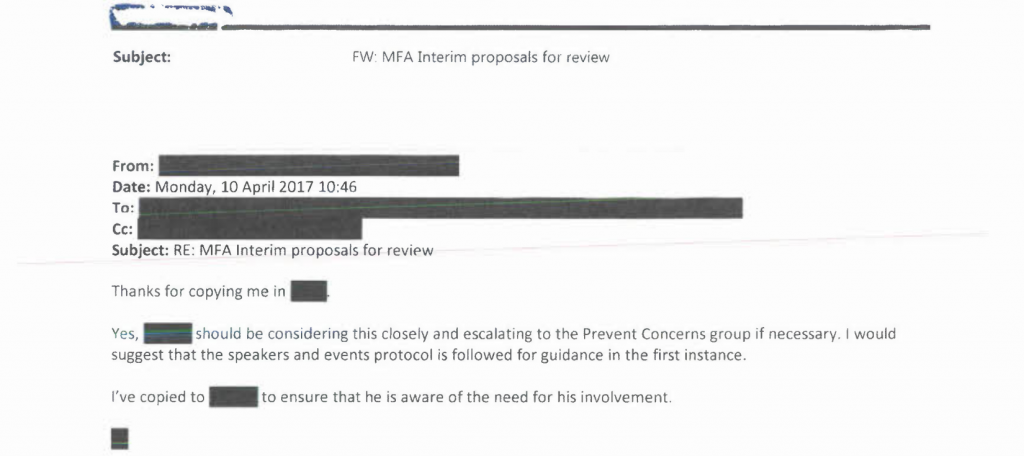 [/vc_column_text][/vc_column][/vc_row][vc_row][vc_column][vc_basic_grid post_type=”post” max_items=”4″ element_width=”6″ grid_id=”vc_gid:1500726862453-8472a316-b3bf-2″ taxonomies=”10100, 8883″][/vc_column][/vc_row]
[/vc_column_text][/vc_column][/vc_row][vc_row][vc_column][vc_basic_grid post_type=”post” max_items=”4″ element_width=”6″ grid_id=”vc_gid:1500726862453-8472a316-b3bf-2″ taxonomies=”10100, 8883″][/vc_column][/vc_row]
[vc_row][vc_column][vc_column_text]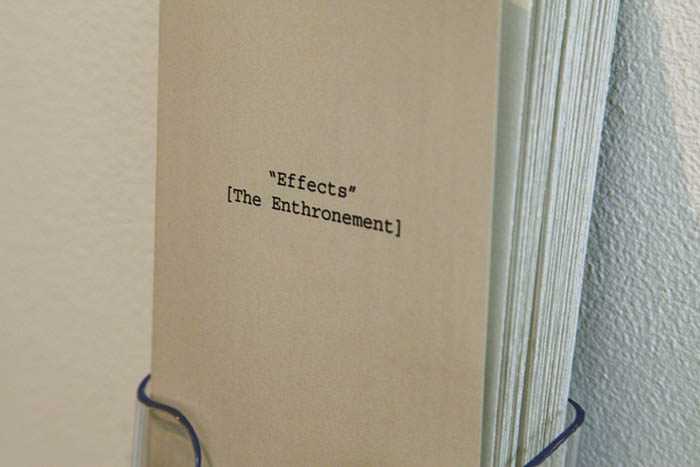
Earlier this month Index on Censorship reported on the Glasgow School of Art’s censoring of master of fine arts student James Oberhelm’s work, which the school deemed to contain “inappropriate content”. This was the first and only time a work of art has been censored in the history of the MFA course.
The work, “Effects” [The Enthronement], is an installation dealing with the geopolitics of the Middle East, specifically the centenary of the Sykes-Picot Agreement.
Duncan Campbell, the Irish Turner Prize winner and former student of the Glasgow School of Art, told Index: “In appropriating such demanding representations there is a difficult discussion about responsibility, accountability, and answerability to be had. If an MFA interim show isn’t the place for this, I don’t know where is.”
The school disagrees. In response to a Freedom of Information request by Scottish Pen for “all correspondence, information or documents held by the GSA regarding the decision to remove the piece… as well as the grounds for its removal”, the school said: “The [senior management team] decided that this particular film should not be shown and that the student be supported in moving forward in terms of professional practice and understanding the implications of their work including the presentation of online sources.”
The film in question was a showreel of two videos issued by Al Hayat, Isis’ media branch, in 2014, showing the dismantling of the border between Iraq and Syria as well as an execution sequence, which Oberhelm sourced from the public domain and included in the artwork.
Oberhelm maintains that the response to the FOI request represents a lack of transparency and told Index that his repeated requests to have the reasons for the decision to censor his work in writing, although promised, have been repeatedly denied.

The flyer for masters student James Oberhelm’s banned artwork “Effects” [The Enthronement]
The school’s Prevent Concerns Group consists of 17 executive and non-executive members, made up of senior staff members including the director, the deputy director and the head of the school of fine art. It is “responsible for the strategic development and implementation of measures to meet the Prevent Duty”.
The UK government’s Prevent strategy for safeguarding communities against the threat of terrorism has been criticised by, among others, Index over concerns it undermines the value of freedom by feeding “the very commodity that the terrorists thrive on: fear.”
During a chance encounter on the street with MFA course director Henry Rogers on 26 April, Oberhelm was given insufficient information on the reasons for the artwork’s removal from the course’s interim show. The encounter followed immediately after Rogers’ meeting with Alistair Payne, the head of the school of fine art at the Glasgow School of Art, during which Rogers was informed of the decision about the installation’s viability for exhibition. Rogers then informing Oberhelm that “the decision is no”
In the moments it took for the pair to walk to the JD Kelly building, a number of points were raised, including Prevent. No great amount of detail was given, but it was hinted that Prevent could be, although wasn’t definitely, the basis for the decision.
Rogers also mentioned that an “ethics form” may have been necessary for the work to be shown, but he seemed unsure. “I informed him that I had not been told that an ethics form was required and that I had completed a risk assessment form,” Oberhelm told Index.
The conversation ended with Oberhelm’s request for a written statement explaining the terms under which the work had been censored, which Rogers said would have to be submitted in writing. Oberhelm’s written request was then forwarded to Alistair Payne the following day. During another meeting between the two on 27 April, Oberhelm was told he would receive the minutes of the meeting during which the decision was made. As of yet, the school has not obliged with either any written explanation or the minutes, negating a basic requirement for institutional transparency.
Since Index published the news of the censoring of Oberhelm’s work, the school hasn’t provided us with any further information, despite our requests, and has not granted us an interview.
“[T]he initial FOI has been answered as have follow up questions and that the GSA has nothing to add to this,” a spokesperson for the school told us.
Campbell told Index: “Given the highly consequential decision they have made, I find GSA’s explanation for the removal of James Oberhelm’s artwork inadequate. An honest statement of the committee’s opinions and objections would have at least given everyone affected something to respond to. By being so wilfully non-committal they might as well have offered no explanation at all.”
Campbell is one of many leading contemporary artists who has studied at the Glasgow School of Art and was the fifth artist who studied at the school, and the fourth artist to take part in the school’s MFA programme, to win the prestigious Turner Prize.
When Campbell won in 2014, the director of the school, Tom Inns, said: “This is a great accolade both for Duncan and for The Glasgow School of Art … Duncan and all the previous GSA winners and shortlisted artists are a great inspiration to the current generation of students and the wider visual art community here in Glasgow.”
But given that Campbell’s Turner Prize-winning work, It For Others, contains an image of IRA volunteer Joe McCann, one has to wonder whether the work Inns offered “warm congratulations” for in 2014 would be censored by the school under Prevent if the artist was an MFA student today. After all, Northern Irish dissident republicans do still pose a threat of terrorism, including in Glasgow.[/vc_column_text][/vc_column][/vc_row][vc_row][vc_column][vc_basic_grid post_type=”post” max_items=”4″ element_width=”6″ grid_id=”vc_gid:1495703925212-684dd380-cb38-4″ taxonomies=”8964, 7516″][/vc_column][/vc_row]